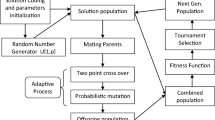Abstract
Knowledge building is an important activity taken up by various organizations. The paper exemplifies the creation of a knowledge-centric environment for a non-profit sector such as a higher education. Building knowledge and thereafter using it are important aspects of knowledge-centric environment; this further helps the organization to gain competitive advantage. With the increase in popularity of genetic algorithm (GA), the technique has been used in building efficient classifiers for creating effective rule sets. The paper makes use of multi-objective genetic algorithm for building GA-based efficient classifier because classification rule mining is itself, a multi-objective problem. Knowledge expressed through classification rules help in establishing relationships between attributes that are not visible openly. The study assumes importance as curriculum planning is an important aspect of any academic institution, the knowledge derived in the form of rules residing in the knowledge base help to substantiate proper curriculum development, making a sizeable contribution toward professional growth and advancement of the students. On implementation of the findings, educational organizations will be able to institute themselves as knowledge centric.

Similar content being viewed by others
References
Rostami NA (2014) Integration of business intelligence and knowledge management—a literature review. J Intell Stud Bus 4:30–40
Surbakti H (2015) Integrating knowledge management and business intelligence processes for empowering government business organizations. Int J Comput Appl 114:36–45
Ashrafi N, Kelleher L, Kuilboer JP (2014) The impact of business intelligence on healthcare delivery in the USA. Interdiscip J Inf Knowl Manag 9:117–130
Sowa JF (2000) Knowledge representation: logical, philosophical and computational foundation. Brook/Cole, Pacific Grove
Rich E, Knight K, Nair SB (2010) Artificial intelligence. TMH, New Delhi
Goldberg DE (1989) Genetic algorithms in search, optimization and machine learning. Addison-Wesley Longman, Boston
Jong KAD, Spears WM, Gordon DF (1993) Using genetic algorithms for concept learning. Mach Learn. doi:10.1007/BF00993042
Aickelin U (2002) An indirect genetic algorithm for set covering problems. J Oper Res Soc 53(10):1118–1126
Schaffer JD (1985) Multiple objective optimization with vector evaluated genetic algorithms. In: Grefenstette JJ (ed) Proceedings of first international conference on genetic algorithms, pp 93–100
Han J, Kamber M (2000) Data mining: concepts and techniques. Morgan Kaufmann Publishers, Burlington
Polanyi M (1966) The tacit dimension. Routledge and Kegan Paul, London
Nickols FW (2000) The knowledge in knowledge management. In: Cortada JW, Woods JA (eds) The knowledge management yearbook 2000–2001. Butterworth-Heinemann, Boston, pp 12–21
Jong TD, Ferguson Hesler MGM (1996) Types and quality of knowledge. Educ Psychol 31:105–113
Gupta P, Mehrotra D, Singh R (2012) Achieving excellence through knowledge mapping in higher education institution. In: Proceedings of international conference on recent advances and future trends in information technology (iRAFIT 2012), Patiala, iRAFIT(8), pp 5–10
Rusli A, Selamat MH, Jaafar A, Abdullah S, Sura S (2008) An empirical study of knowledge management system implementation in public higher learning institution. Int J Comput Sci Netw Secur 8:281–290
Sahay A, Mehta K (2010) Assisting higher education in assessing, predicting, and managing issues related to student success: a web-based software using data mining and quality function deployment. In: Proceedings of Academic and Business Research Institute Conference, Las Vegas, pp 1–12
Sagsan M (2009) Knowledge management discipline: test for an undergraduate program in Turkey. Electron J Knowl Manag
Wright H (2008) Tacit knowledge and pedagogy at UK universities; challenges for effective management. Electron J Knowl Manag 6(1):49–62
Cranfield DJ, Taylor J (2008) Knowledge management and higher education: a UK case study. Electron J Knowl Manag 6(2):85–100
Dutta D, Dutta P (2010) Optimized classification rule set generation using pareto based binary coded elitist multi objective genetic algorithm. In: Conference proceeding of 4th international conference on intelligent systems and networks Haryana, India
Dutta D, Sil J (2013) Evolution of genetic algorithms in classification rule mining. In: Bhattacharyya S, Dutta P (ed) Handbook of research on computational intelligence for engineering, science, and business, vol 1. IGI Global, Hershey, PA, USA, pp 328–363
Zhong-Yang X, Lei Z, Yu-Fang Z (2004) A classification rule mining method using hybrid genetic algorithm. In: Proceedings of IEEE region 10 conference (TENCON 2004) Chiang Mai, Thailand: IEEE, pp 207–210
Dehuri S, Patnaik S, Ghosh A et al (2008) Application of elitist multi-objective genetic algorithm for classification rule generation. Appl Soft Comput 8(1):477–487. doi:10.1016/j.asoc.2007.02.009
Dutta D (2009) Classification rules generation for iris data using lexicographic pareto based multi objective genetic algorithm. In: Conference proceedings of 3rd international conference on intelligent systems and networks (IISN 2009), At Klawad, Haryana, India, pp 173–177
Kaya M (2010) Autonomous classifiers with understandable rule using multi-objective genetic algorithms. Expert Syst Appl 37(4):3489–3494. doi:10.1016/j.eswa.2009.10.039
Dutta D, Dutta P (2011) A real coded MOGA for mining classification rules with missing attribute values. In: Proceedings of international conference on communication, computing and security, India, pp 355–358
Gupta P, Mehrotra D, Sharma TK (2015) Genetic based weighted aggregation model for optimization of student’s performance in higher education. In: Proceedings of fifth international conference on soft computing for problem solving volume 436 of the series, advances in intelligent systems and computing, pp 877–887
Gupta P, Mehrotra D, Sharma TK (2016) Role of decision tree in supplementing tacit knowledge for hypothetico-deduction in higher education. Int J Syst Assur Eng Manag. doi:10.1007/s13198-016-0483-6
Deb K, Pratap A, Agarwal S, Meyarivan T (2002) A fast and elitist multi objective genetic algorithm: NSGA—II. IEEE Trans Evol Comput 6(2):182–197
Zitzler E, Thiele L (1998) An evolutionary algorithm for multiobjective optimization: the strength pareto approach computer engineering and networks laboratory (TIK). Zürich, Swiss Federal Institute of Technology Zürich (ETH). doi:10.3929/ethz-a-004288833
Acknowledgements
Authors would like thank the anonymous reviewers for their valuable suggestions and comments to improvise the manuscript.
Author information
Authors and Affiliations
Corresponding author
Ethics declarations
Conflict of interest
Authors declare that they do not have any conflict of interest.
Rights and permissions
About this article
Cite this article
Gupta, P., Sharma, T.K., Mehrotra, D. et al. Knowledge building through optimized classification rule set generation using genetic based elitist multi objective approach. Neural Comput & Applic 31 (Suppl 2), 845–855 (2019). https://doi.org/10.1007/s00521-017-3042-4
Received:
Accepted:
Published:
Issue Date:
DOI: https://doi.org/10.1007/s00521-017-3042-4




